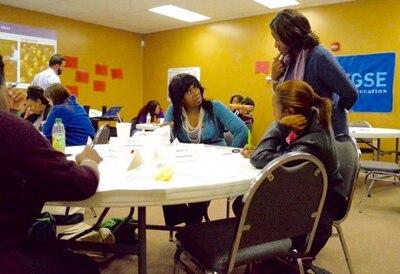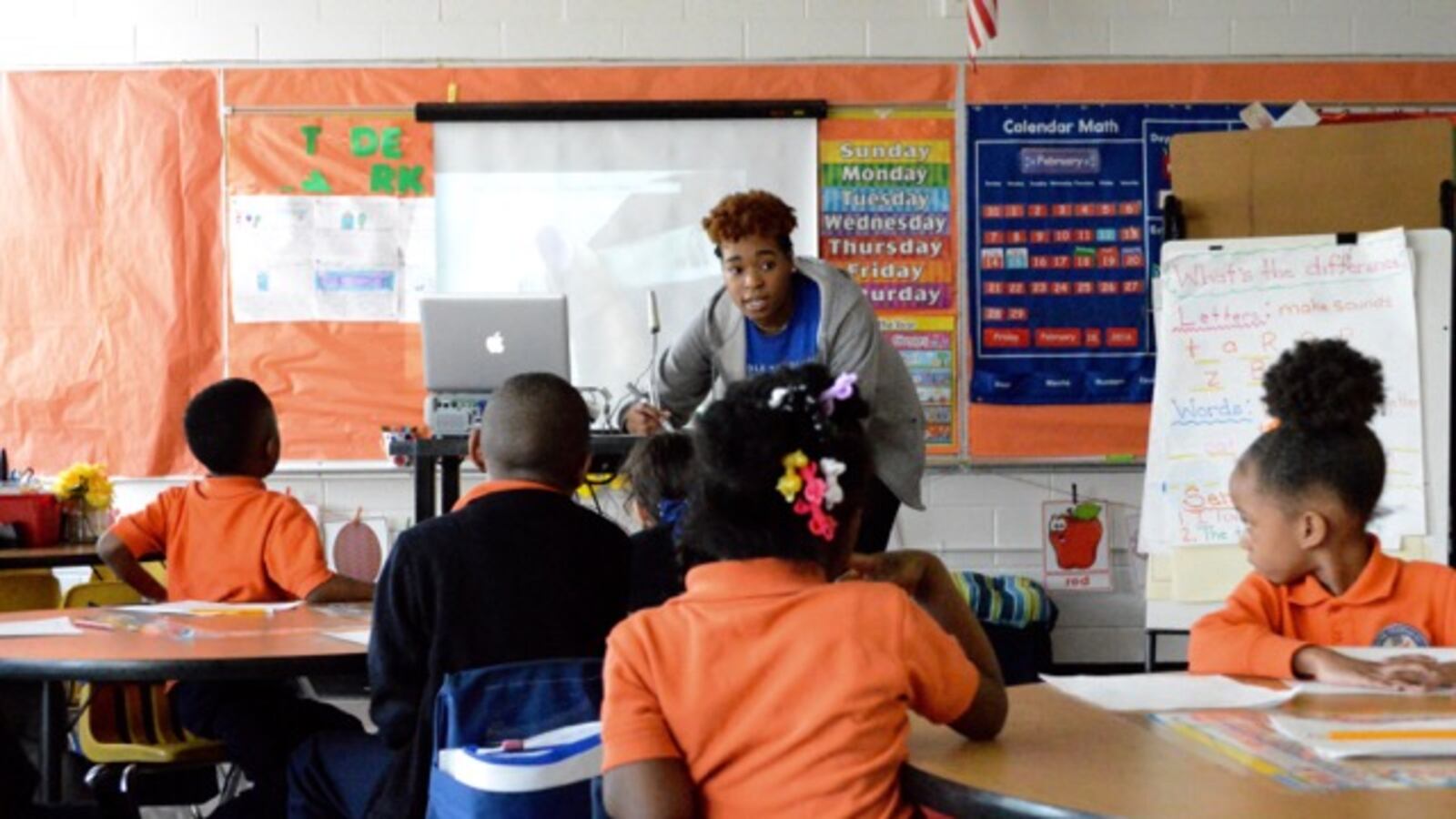Sitting at a knee-high table surrounded by seven kindergarteners in a Memphis classroom, Sharon Johnson launches into a call-and-response chant to help her students explore the joy of phonetics.
“I’ve got a word,” she sings.
“What’s your word?” they respond.
“The word is cop!” she sings.
Captivated, the children quickly begin holding up fingers to show the number of sounds they hear. Around the table, multiple sets of three tiny fingers shoot in the air.
Johnson continues with all the ease of an experienced teacher. Except that she’s not.
She recently completed her first year as a teacher-in-training, getting hands-on classroom experience at Freedom Preparatory Academy as part of her two-year training program through New York-based Relay Graduate School of Education.
Relay just completed its first year of operation in Memphis, where it’s among a handful of programs that have sprung up in recent years to provide alternative routes to teaching in response to the city’s need for more educators. Such independent programs have gained considerable momentum and legitimacy with the support of philanthropists and the authorization of higher education governance bodies such as the Tennessee Higher Education Commission.
“We knew there was a need in Memphis; we knew there were roughly 25,000 students in priority schools” that are academically in the state’s bottom 5 percent, explains Michelle Armstrong, dean of Relay Tennessee and lead instructor for the Memphis campus.
Relay is different from traditional university programs in that it emphasizes hands-on practice as much as theory. It has charter school roots, having been founded in 2007 in New York City by the leaders of three charter school networks, including KIPP. Relay is now in nine states and has 12 campuses that include Nashville, Chicago, Denver, New Orleans and Baton Rouge, with efforts underway to expand to California.
Relay Graduate School of Education in Memphis from Chalkbeat Tennessee on Vimeo.
Relay’s first-year students, known as teaching assistants, are introduced to life in the classroom while also preparing to take teacher certification exams. Second-year students work full time as teachers in charge of their own classrooms, often at charter schools, while completing a master’s degree and earning a teaching license.
“They’re using this year as sort of a gradual ‘on-ramp’ into teaching,” explained Armstrong about the gradual increase in teaching responsibilities during their first year. “The hope is that first-year students will come back and work toward their master’s.”
Johnson is an example of the kind of students attracted to the nontraditional teaching program.
“I did my research, and the main reason I chose Relay is because everything they do is hands-on. They model the most effective teaching methods,” said Johnson, who already has a bachelor’s degree in English and a minor in secondary education from the University of Tennessee at Knoxville.
Research and criticism
But that approach has drawn criticism from the teacher-preparation establishment, which has itself been criticized for failing to provide would-be teachers with enough real-life experience.
Earlier this month, the Colorado-based National Education Policy Center published a brief concluding that research has yet to show that increasingly popular independent teacher training programs like Relay are better than the traditional route.
Relay officials agree that the research is inconclusive. Part of the reason, scholars say, is that individual teacher training programs vary widely in what they require of their trainees.
“No one really knows what is the best way,” said Mayme Hostetter, Relay’s national dean. “But we see this as one very good way to have folks enter the profession — and we’ve gotten positive feedback from the residents themselves, as well as from the schools we’ve worked with.”
To earn their master’s degrees, teachers must meet student learning goals that their students will achieve a year’s worth of reading growth. In fact, Hostetter said, Relay’s own data shows that elementary students taught by its residents experience an average of 1.3 years’ worth of reading growth per year.
“Those aren’t data we’re holding up to the world saying, ‘Incontrovertible truth! We are better than anywhere else,’” Hostetter said. However, she said Relay does see them as a positive sign.
"... The main reason I chose Relay is because everything they do is hands-on. They model the most effective teaching methods."
Sharon Johnson
But Ken Zeichner, a professor at the University of Washington’s College of Education, argues that alternative teacher training programs rely too heavily on test scores. He’s also critical of Relay for promoting the use of highly controlling pedagogical and classroom management techniques in schools serving students of color and low-income communities. Such programs, he argues, focus on preparing teachers to teach “other people’s children,” not those teaching economically advantaged children.
“From my perspective, by only looking at test scores, we’re creating a second-class education for poor children in this country that (is) just about test scores,” Zeichner said in an interview.
Zeichner writes that teacher preparation programs, including university-based programs, should be judged by a mix of factors, including standardized test scores and how their graduates increase students’ social and emotional skills, creativity and problem-solving abilities.
Hostetter agrees. “Those goals are incredibly noble and what we’re working toward,” she said. For now, she said Relay focuses on teaching residents how to build relationships with students, create a strong classroom culture, manage a classroom and teach academic lessons.
As for Relay’s teaching techniques, Hostetter said she doesn’t understand Zeichner’s criticism. “It’s pretty straightforward,” she said.
Learning by doing
Johnson modeled Relay’s classroom approach in her work last year at Freedom Prep. Under her leadership, her energetic 5-years-old were attentive and still — behaviors that she attributes to Relay’s teaching techniques and the school’s culture.
“We try to meet them on their level,” Johnson explains, citing lessons that are paced and efforts to call on as many students as possible. There are “wiggle breaks” too, to help the youngsters during focused periods of teaching and learning.
Johnson learned the teaching techniques during a weekly Relay class called “deliberate practice.”

“I need everyone’s back straight and feet flat on the floor,” Armstrong tells 16 aspiring educators as she strolls from table to table while weaving in gentle reminders about posture.
Armstrong is trying to teach behaviors — such as sitting up straight, listening, and “tracking” the speaker with their eyes — using techniques that she hopes her students will mimic when they are lead teachers.
Johnson says those techniques have equipped her to transition to the front of the classroom.
“I just feel prepared,” she said of the experience. “Like, this is a hard job, but getting to see what works immediately, it just gives me confidence.”
Chalkbeat Colorado reporter Melanie Asmar contributed to this report.

